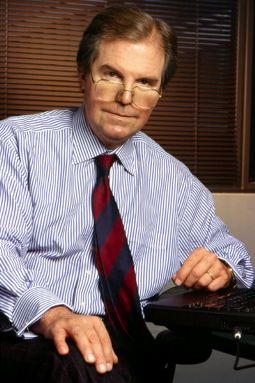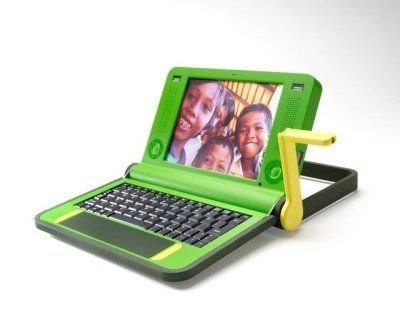 |
To admirers and associates, Nicholas Negroponte is a brilliant mind, a gifted businessman, a generous philanthropist, a 21st century visionary, and a pioneer of technology in education.
All these complimentary connotations are true, and yet, in the eyes of the children whose lives he has touched, he is simply the man who gave them access to a laptop computer when, in most cases, they had never before seen one, let alone dreamt of owning one... who allowed their education to reach new heights... who put them in touch with a worldwide network of students... and most importantly, who believed in them despite the odds. To them, Nicholas Negroponte is a weaver of dreams and a restorer of hope.
Best known as the founder and chairman of MIT's renowned Media Lab, Negroponte grasped the importance of computers and technology in education long before the majority of Americans even knew what a computer was, or how it could benefit modern lives.
Considered a pioneer in the computer-aided design field, Negroponte, himself a graduate of MIT, has been a faculty member since 1966.
He founded MIT's Architecture Machine Group in 1967 as a lab and research center focusing on human-computer interaction. By the time the computer revolution hit in the 1980s, Negroponte had long been on board, and co-founded the MIT Media Lab along with Jerome B. Wiesner in 1985, a concept he had helped mastermind in 1980. The lab soon came to be considered a preeminent computer science laboratory, and propelled MIT to even higher technological and educational advancements.
 |
Negroponte's vision did not end there. A gifted businessman, Negroponte has invested in over 40 start-up companies over a span of several decades, including Ambient Devices, Zagats, and others, and continues to serve on the board of directors of technological giant Motorola.
In 1992 he also became the first investor for Wired Magazine. A gifted writer, for the following 5 years he also contributed a monthly column to it.
Reemploying many of the ideas from his Wired columns, he authored, Being Digital in 1995, a bestseller that would eventually be translated into forty different languages. In it, Negroponte expanded on his belief that the worlds of technology, entertainment, and information would merge into one global interactive universe.
Although he continued teaching at MIT for some time following, in 2000 Negroponte left a prestigious position -- Chairman of MIT's Media Lab -- to focus on the educational well-being of children he has never personally met and, in most cases, never will. His passionate focus is his philanthropically brilliant One Laptop Per Child non-profit project, which has since come into the international limelight.
In November of 2005 Negroponte's $100 laptop, coined The Children's Machine, was globally unveiled at the World Summit on the Information Society in Tunisia. The summit, sponsored by the United Nations, aimed to bridge the 'digital divide' -- the discrepancy in technology and Internet access between poor and rich nations.
Negroponte's affordable laptop, designed for students in the developing world, is perhaps the perfect solution to the digital divide. With new technology in hand, students will finally have an opportunity to access the Internet, both expanding their educational opportunities, and providing them with a viable invitation to participate in the greater global community.
Negroponte's prototype laptop design cuts costs dramatically as a simplified version of a typical laptop, hosting a smaller 7.5" screen, less-marketed Linux software, and most importantly, drastically-diminished marketing and sales expenses.
Having taken all things into design consideration, even children living in remote villages without power or telephone utilities can use the laptop, thanks to a brilliant design that includes a hand crank for power instead of a power cord. The laptop is also housed in an incredibly sturdy rubber case to prevent damage, and comes with a screen so bright that it can be taken outside and read like a book. The design also took Internet connectivity into consideration, of course, embedding a local network connector of sorts that serves 1000 students with just 2 MB.
Understanding that, for many families worldwide, $100 is an exorbitant amount of money, the goal is for the laptops to become government-issued educational products, distributed freely to students.
Already an international sensation, Negroponte has received millions of international orders for the laptops -- from South Africa, Egypt, Brazil, Thailand, China, and others. Backed by Google, the News Corporation, and others, the key to the success of the program is volume: the more orders placed, the more countries that jump aboard, the better and even perhaps less expensive the computers can be.
And what about the potential for their redistribution at higher costs in a grey market? Negroponte and his team have included this into their design as well -- with their bold fluorescent colors, their distinctive design, etc. Negroponte is ensuring that the laptops are easily recognizable as a government sponsored and distributed learning resource, the theft of which Negroponte compares to that of a post office truck -- blatant, socially unacceptable, and uncommon.
Negroponte's visionary mind, which recognized the power of computer technology long before the majority of the world had awakened to it, is now propelling the future of education -- building the bridge across the digital divide, starting with the youngest minds.
Negroponte calls it "inventing the future," while the children whose lives he has changed mostly see it as simply having been given the chance at one.
Perhaps one day all children will own a laptop, even those in the most remote villages, those living in poverty, those without basic necessities like power and running water -- yet with access to a vast and wonderous world at their fingertips, a future as colorful as the neon color of their laptop, as bright as the thoughtfully designed monitor, and as brilliant as their freed potential.
Page created on 8/30/2007 7:42:36 AM
Last edited 11/24/2018 6:23:46 PM
